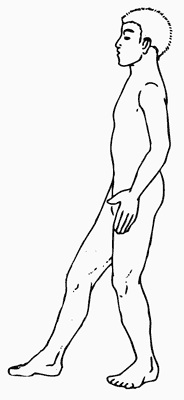You already have an idea of three static poses where the body weight is distributed on both legs. In this section we will look at the so-called “side pose”, in which there is only one supporting leg.
The supporting leg is placed at an angle of 45° relative to the other, which is placed forward in such a way that 70% of the body weight falls on the supporting leg. You can take a step forward with either foot. If the left leg is behind, the pose is called “left-sided” and vice versa. Having studied it, you will automatically double the number of poses you know. Thus, by practicing the well-known three static poses in combination with the “support on one leg” pose, the number of possible static forms will increase to six. By alternating between “right-handed” and “left-handed” poses, you will increase this number to nine. So, let's consider the “left-sided” pose, in which the emphasis is on the left leg.

1. Take one of the poses you know: “standing with your arms at your sides,” “hugging a tree,” or “hands on your head.”
2. Take a step forward with your right foot 30-45 cm. The left foot is almost in line with the right.
3. The left leg is turned to the side at an angle of 45°.
4. Distribute your body weight so that your right leg accounts for 30% and your left leg for 70%. The main weight of the body should fall on the left leg.
5. Turn your body and hips towards your right leg. The center of gravity shifts to the left leg as the hips take the designated position.
6. Slightly spread and then bring your knees together. This will complete the stabilization of the groin area (opens the gua) and help gain stability.
7. Bend your knees and squat slightly. The knees should not protrude beyond the toes (tension of the back muscles of the legs makes the pose more stable). Bend slightly to activate the sacral pump.
8. Do not lift your feet off the floor so as not to lose your energetic connection with the earth.
9. Remain in this position for 3-5 minutes, during which you can perform the previously learned internal exercises.
10. If desired, you can perform the exercise again, changing the “left-sided” pose to the “right-sided one.”
When performing this exercise, pay attention to the rotation of your knees. I will give other details related to its implementation in subsequent chapters.



